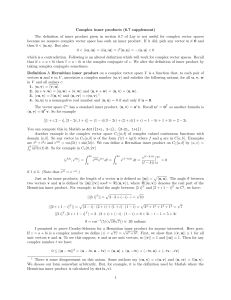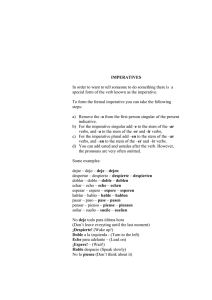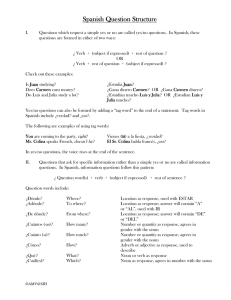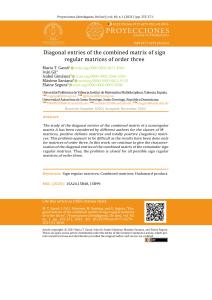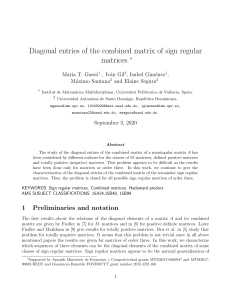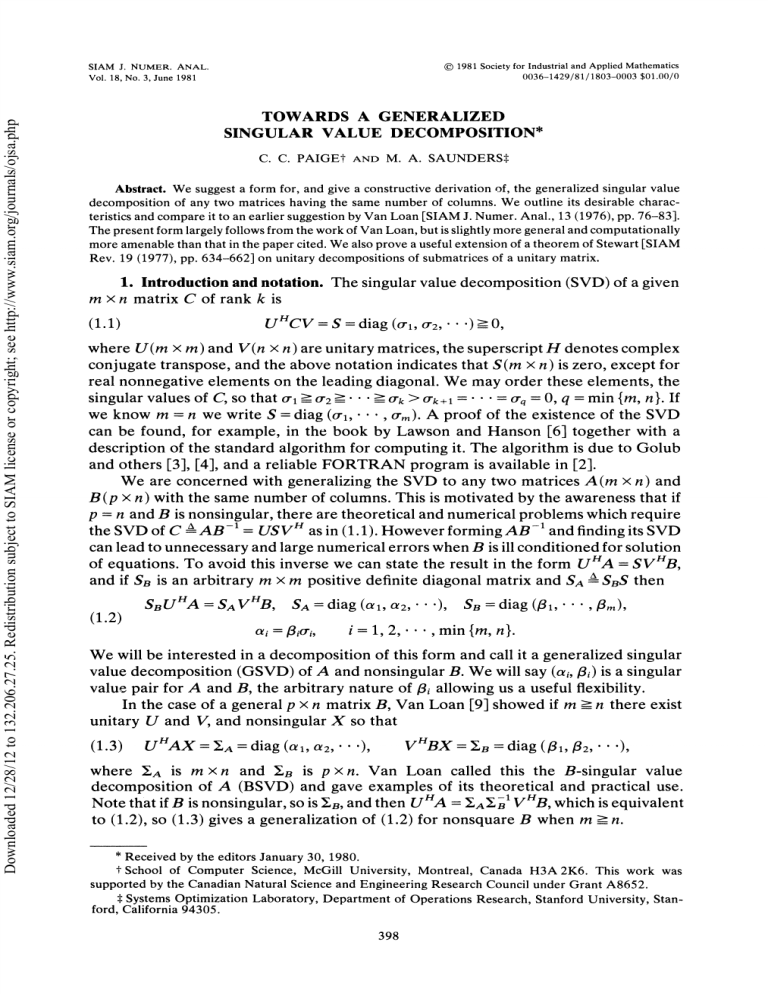
1981 Society for Industrial and Applied Mathematics
0036-1429/81/1803-0003 $01.00/0
Downloaded 12/28/12 to 132.206.27.25. Redistribution subject to SIAM license or copyright; see http://www.siam.org/journals/ojsa.php
SIAM J. NUMER. ANAL.
Vol. 18, No. 3, June 1981
TOWARDS A GENERALIZED
SINGULAR VALUE DECOMPOSITION*
C. C. PAIGE"
AND
M. A. SAUNDERS:
Abstract. We suggest a form for, and give a constructive derivation of, the generalized singular value
decomposition of any two matrices having the same number of columns. We outline its desirable characteristics and compare it to an earlier suggestion by Van Loan [SIAM J. Numer. Anal., 13 (1976), pp. 76-83].
The present form largely follows from the work of Van Loan, but is slightly more general and computationally
more amenable than that in the paper cited. We also prove a useful extension of a theorem of Stewart [SIAM
Rev. 19 (1977), pp. 634-662] on unitary decompositions of submatrices of a unitary matrix.
m
1. Introduction and notation. The singular value decomposition (SVD) of a given
n matrix C of rank k is
(1.1)
uHcv
S diag (0-1, 0"2,
") 0,
where U(m m) and V(n n) are unitary matrices, the superscript H denotes complex
conjugate transpose, and the above notation indicates that $(m n) is zero, except for
real nonnegative elements on the leading diagonal. We may order these elements, the
singular values of C, so that 0"1 => 0-. =>" => 0-k > 0-k /
0-q 0, q min {m, n }. If
we know m n we write S diag (0"1,
0",). A proof of the existence of the SVD
can be found, for example, in the book by Lawson and Hanson [6] together with a
description of the standard algorithm for computing it. The algorithm is due to Golub
and others [3], [4], and a reliable FORTRAN program is available in [2].
We are concerned with generalizing the SVD to any two matrices A(m n) and
B (p n) with the same number of columns. This is motivated by the awareness that if
p n and B is nonsingular, there are theoretical and numerical problems which require
the SVD of C a___ AB-1 USV H as in (1.1). However forming AB -1 and finding its SVD
can lead to unnecessary and large numerical errors when B is ill conditioned for solution
of equations. To avoid this inverse we can state the result in the form UHA SVHB,
and if Sn is an arbitrary rn x rn positive definite diagonal matrix and SA a_ SnS then
,
(1.2)
SBUHA SAVHB,
Oli
SA =diag (al, o2,"" ’)) SB =diag (1,""’, [rn),
1, 2,"
[-i0"i,
min {m, n }.
We will be interested in a decomposition of this form and call it a generalized singular
value decomposition (GSVD) of A and nonsingular B. We will say (ai,/i) is a singular
value pair for A and B, the arbitrary nature of/i allowing us a useful flexibility.
In the case of a general p n matrix B, Van Loan [9] showed if m => n there exist
unitary U and V, and nonsingular X so that
(1.3)
uHAx --A =diag (al, 02,"
V HBX .,B =diag (1, 2," "),
’),
where "’A is m x n and B is p n. Van Loan called this the B-singular value
decomposition of A (BSVD) and gave examples of its theoretical and practical use.
Note that if B is nonsingular, so is ,EB, and then UnA ,AVZ 1VHB, which is equivalent
to (1.2), so (1.3) gives a generalization of (1.2) for nonsquare B when rn -> n.
* Received by the editors January 30, 1980.
School of Computer Science, McGill University, Montreal, Canada H3A 2K6. This work was
supported by the Canadian Natural Science and Engineering Research Council under Grant A8652.
Systems Optimization Laboratory, Department of Operations Research, Stanford University, Stanford, California 94305.
398
Downloaded 12/28/12 to 132.206.27.25. Redistribution subject to SIAM license or copyright; see http://www.siam.org/journals/ojsa.php
TOWARDS A GENERALIZED SINGULAR VALUE DECOMPOSITION
399
Van Loan [9] pointed out that there are difficulties in computing (1.3). We can
understand this if we choose unitary O so that X-1O R is upper triangular and
combine this with (1.3) to give
UnAQ ,AR,
VHBQ ER.
(1.4)
Here the unitary transformations do not alter the 2-norms of the matrices (1[C112 O’1 in
(1.1)), ,and we could hope to find the transformations of A and B in (1.4) in a
-1
numerically stable computation. However, R and X QR can be ill conditioned no
(e 11) for very small
matter how we choose the diagonal matrices; e.g., R
e. Thus the
0
transforming matrix X in (1.3) can be ill conditioned, and in general we cannot expect to
compute the transformations of A and B in (1.3) in a numerically stable way. This
argument also points to (1.4) as a more desirable form for the GSVD with a general
p x n matrix B than (1.3).
In 2 we derive a possible form of the GSVD for general A and B having the same
number of columns. The theoretical development of this in some ways parallels that in
[9], but the result is essentially of the form (1.4) rather than the form (1.3), and is likely
to be more amenable to reliable computation than the form (1.3). There are also no
restrictions on m, n, or p. Section 3 relates the suggested GSVD to the BSVD of [9], and
considers some properties of this GSVD. In 4, a result of 2 is used to generalize a
known result on unitary matrices. Section 5 summarizes the paper and briefly considers
some computational aspects.
2. A generalized singular value decomposition. Here we give a constructive
development of a GSVD of A(m x n) and B(p x n) with no restrictions on m, n, or p.
We make extensive use of unitary transformations. In particular, we can find unitary
matrices P and Q to transform a given matrix C to the form
pHCQ=
(2.1)
(R00’0)
where R is nonsingular with the rank of C. This can be computed directly in a
numerically stable way resulting in upper triangular R (see for example, [6]) but the
rank determination may not be trivial. We can avoid such difficulties by computing
the SVD of C, as in (1.1), but this is an iterative process and is computationally more
expensive. Note that in either case, the singular values of R are the nonzero singular
values of C.
H
(A H, B H)
We will now indicate how to derive a GSVD of A and B by taking C
and examining the SVDs of submatrices of P in (2.1).
H
(A H, B H) and k
THEOREM. For given A(m x n) and B(p x n) with C
rank (C), there exist unitary matrices U(m x m), V(p x p), W(k x k), and Q(n x n)
giving
(2.2)
U’-’AQ ,a(WIR,
0
V’-’BQ E,(W’-’R,
I
(2.3)
-"A
O
,B
SA
OA
mxk
r
0
n-k
k
n-k
k
s
k-r-s
A__
SB
I
p xk
r
s
k-r-s
where R (k x k) is nonsingular with singular values equal to the nonzero singular values of
Downloaded 12/28/12 to 132.206.27.25. Redistribution subject to SIAM license or copyright; see http://www.siam.org/journals/ojsa.php
400
C. C. PAIGE AND M. A. SAUNDERS
C. Ia(rXr) and IB(k-r-sxk-r-s) are unit matrices, Oa(m--r--s xk-r-s) and
OB(p- k + r x r) are zero matrices with possibly no rows or no columns, and SA
diag (r+x,
cr+s), SB &diag (/3+1,
+) are real s x s matrices. We have
< 1,
0<
1 > ,+a
(2.4)
a+ > 0,
,
,
.
+
+ 2 =1,
(2.5)
.
+
i=r+l,...,r+s.
Proof. In (2.1) let
p’
(2.6)
n
kP21 P22} p"
k
k
n-k,
k
We have IIP 12 []Pl12 1, so no singular value of P is greater than unity, and we may
write the SVD of P as
UP
(2.7)
with
W ZA,
Za as in (2.3) and (2.4). Now consider the decomposition
V" (P21 W)
(2.8)
t
where unitary V is chosen so that L(p x k) is lower triangular with real nonnegative
diagonal finishing in the bottom right hand corner, i.e., i 0 if p > k -], and i 0
if pk-f. The details of this type of triangularization can be found in [5] and [6].
The matrix
clearly has orthonormal columns, and from the form of N in (2.3)
L=N,
(2.10)
where
gives
N
is as in (2.3), (2.4), and (2.5). Combining (2.1) with (2.6), (2.9), and (2.10)
O (PR, 0)=
VNWR
from which (2.2) follows, completing the proof.
Comments. If p n and B is nonsingular, then k
(2.11)
UHAQ=( Sa oA) WHR,
vHBQ
0
n, and (2.2) becomes
( SB IB) WHR,
giving the form of (1.2)
(2.12)
(S ) U,A ( SA Oa)
so the theorem gives a generalization of (1.2) to general nonsquare B. We see we have
only unitary transformations of A and B in (2.2), and the comment following (1.4) will
apply here.
We note that A and B have been treated identically here, apart perhaps from the
can be exchanged if those of
ordering of elements in (2.3). But the diagonal blocks of
E are exchanged in the same way, and similarly for the diagonal elements of SA and SB.
Because of this equal treatment we can refer to (2.2) as a GSVD of A and B, rather than
-a
Downloaded 12/28/12 to 132.206.27.25. Redistribution subject to SIAM license or copyright; see http://www.siam.org/journals/ojsa.php
TOWARDS A GENERALIZED SINGULAR VALUE DECOMPOSITION
401
a BSVD as in [9]. There is an easy to remember symmetry in (2.3), the significant
elements of Ea are on the diagonal starting in the top left corner, and are nonincreasing
moving farther from this corner, while the significant elements of ZB are on the diagonal
finishing in the bottom right corner, and are nonincreasing going away from this corner.
Finally, we note that if R is the diagonal matrix of singular values of C in (2.1), then
(2.2) involves these and the singular value pairs of A and B in a simple way which may
be quite useful for theoretical pursuits such as perturbation analyses.
3. Some properties o this GSVD. We can relate the decompositions in (2.2) to
the work of Van Loan [9] as follows. We have
UHAX
(3 1)
(EA, 0),
VHBX
(EB, 0), X &
Q(R-I0
\
1/
and if p _-> k in (2.3), we can move the first p k rows of V H to be the last p k rows, so
that ZB is now zero except for its leading diagonal. The result is equivalent to that in [9],
and we certainly have p >_-k here if p >_-n, which is equivalent to the restriction in [9]
(exchanging A and B).
We can ascribe n singular value pairs (ci,/3i), i-1,..., n to A and B, one
corresponding to each column of UHAX and vHBx in (3.1). Following (2.3) we take
for the first k of these
(3.2)
a
(3.3)
a,
(3.4)
1, i
0
i= 1,’’’, r,
,
r + s,
r + 1,.
i as in Sa and SB,
ai=O, /=1, i=r+s+l,...,k,
and call these nontrivial pairs. Since the remainder correspond to the zero columns in
(3.1) and have no particular numerical values attached to them, we will call them the
n- k trivial singular value pairs of A and B.
When B is nonsingular the singular values of AB -1 are ogi/i so in analogy we
could talk of generalized singular values and refer to those in (3.2) as infinite, those in
(3.3) as ordinary, those in (3.4) as zero, and the remainder as arbitrary or undefined
generalized singular values of A with respect to B. The use of pairs avoids this
distinction between A and B.
An interesting example mentioned in [9] is
(3.5)
A=(1, 0),
B=(0, 1).
This corresponds to Oa and OB in (2.3) having no rows, but one column each. There is
one singular value pair as in (3.2) and one as in (3.4).
In [9] Van Loan showed that these singular value pairs correspond to the following
generalization of the singular value concept from the one matrix C to two matrices
A(rn x n) and B(p x n):
In [9]
-
Find the singular value pairs (a,/3), a 2 i[ 2 7 0,
(3.6)
so that det
a
O
__--> 0, / __--> 0,
(fl2AHA-aZBHB)=O.
1, but here A and B have equal rights. We exhibit this correspondence in
c.c.
402
PAIGE AND M. A. SAUNDERS
Downloaded 12/28/12 to 132.206.27.25. Redistribution subject to SIAM license or copyright; see http://www.siam.org/journals/ojsa.php
terms of our GSVD (2.2), as the result is marginally more complete than in [9]. Note that
det (B2A"A-a2B"B)
R"W
=det
282A
0
-
282B
(WHR’O)
2IB
Since the n n matrix whose determinant we are considering has rank at most k, we can
say there are n-k arbitrary pairs (a, B); these are the trivial pairs. We see the
remaining pairs are just the nontrivial pairs given in (3.2), (3.3), and (3.4).
4. Decomposition of unitary matrices. Stewart [7] proves that if P is unitary of
dimension m + p with m <-p, then there exist unitary,matrices U and W of dimension
m, and V and Z of dimension p, so that
U
(4.1)
g
0
m
VH
W 0
P
0 Z
p
m
0
p
C -S
S C
o
o
m
m
0
0
)m
m,
with real S and C, such that
C
(4.2)
(4.3)
(4.4)
diag (a 1,
am),
1 ->_a _->’
S diag (ill,""",/m),
01
C2+$2--L
Cern
’’" </m
1,
The matrix on the right side of (4.1) is a generalization of an orthogonal rotation matrix,
and its transpose is its inverse.
Stewart [7] notes that this result is implicit in the work of Davis and Kahan 1 ], and
points out that it "often enables one to obtain routine computational proofs of
geometric theorems that would otherwise require considerable ingenuity to establish".
Van Loan 10] emphasizes this and shows how it can be used to analyze some important
problems involving orthogonal matrices. Unfortunately, this result could not be used
directly here, as P in (2.6) had no square submatrices of interest in the general case.
However, we have effectively used a generalization of (4.1) to prove the GSVD
theorem in 2. This shows a need for this generalization and so we will present it in full
here.
THEOREM. Let P be a unitary matrix of dimension m + p k + q, then there exist
unitary matrices U, V, W, Z of dimensions m, p, k, q respectively, so that
H
I
r
S
(4.5)
0
m
V
H
p
P
Oc
W
Os
0
k
m -r-s
p-k+r
I
S
q
S
k -r-s
I
r
(4.6)
(4.7)
s
C diag (ar+l,""", ar+s),
S diag (fir+a,"’,/3+s),
k-r-s p-k+r
s
m-r-s
> O,
"
O<r+l""" <flr+s < 1,
1 > ar+l
Olr+s
TOWARDS A GENERALIZED SINGULAR VALUE DECOMPOSITION
C2+$2=L
(4.8)
Downloaded 12/28/12 to 132.206.27.25. Redistribution subject to SIAM license or copyright; see http://www.siam.org/journals/ojsa.php
403
Proof. We have the same partitioning of P as in (2.6), so (2.9) and (2.10) with (2.3)
show that there exist U, V and W giving the first k columns in (4.5). Next, choosing Z to
be unitary so that Ut4P12Z has the form of L H in (2.8), and using an argument like (2.9)
and (2.10), gives the first m rows of (4.5). Since each side of (4.5) is a unitary matrix we
have
vHp22 Z
Olp-k+r
F
H
G
N 0
0
0
p-k+r
s
s
0
and SC + NS 0, so N -C, and then G H H 0 and F is unitary. We then obtain
(4.5) by making the obvious unitary transformation of either V or Z.
Comments. Oc and Os may be nonsquare here, and (4.5) is not so easy to
remember as (4.1). However, this difficulty is lessened when we note that the leading
m x k diagonal block, and trailing p x q diagonal block, is zero, except for the diagonal
starting in the top left corner, with nonincreasing elements moving away from this
corner. The remaining off diagonal blocks are zero, except for diagonals starting in the
bottom right corners, with nonincreasing elements moving away from these corners.
We can obtain a more familiar form, given a particular 2 x 2 block partition of a
unitary matrix by possibly exchanging blocks of rows, blocks of columns, and transposing to give for P
m
p
(4.9)
Pll P12
P21 P22
k
q
With this ordering of dimensions it can be shown that there exists a transformation of
the form in (4.5), giving for the transformed P
\
-S
C
I
(4.10)
S
C
I
k
m-k
k
m-k
k
p-k
k p-k
C2+
L but the nonnegative diagonal matrices C and S may have diagonal
elements of unity or zero. This is now seen to be a simple, but necessary and nontrivial,
generalization of (4.1).
The form (4.10) is dependent on the ordering of the dimensions; whereas the
decomposition (4.5) is quite general. Thus, although the parallel with rotation matrices
is not so obvious, the form (4.5) will probably be marginally easier to use in the general
case than (4.10).
Here
S 2--
5. Remarks. Although good computational practice has been kept in mind, this
remains an essentially theoretical paper. We have presented a possible form for the
generalized singular value decomposition of two matrices A and B having the same
number of columns. This decomposition holds for all such pairs, and treats A and B
equally. In essence, we have shown there exist unitary matrices U, V, W, and Q, so that
(5.1)
UI4AQ --.A(WHs, 0),
VHBQ Y_,B(wHs, 0),
Downloaded 12/28/12 to 132.206.27.25. Redistribution subject to SIAM license or copyright; see http://www.siam.org/journals/ojsa.php
404
C. C. PAIGE AND M. A. SAUNDERS
where S is the diagonal matrix of the nonzero singular values of (A H, BH), while Y-"A and
51B are zero, except for real nonnegative leading and trailing diagonals respectively.
These are related by
EAnZA + ZZB =Ik,
(5.2)
and it is these diagonal elements which give the singular value pairs for A and B. The
right hand sides in (5.1) involve the singular value pairs, a unitary matrix, and the
singular values of (A B n). Such forms may prove useful for perturbation analyses, but
we have not studied this.
We have also presented the full generalization of a theorem by Stewart [7]. In fact,
our generalized singular value decomposition could have been proven directly by
making use of this extended result on the decomposition of a unitary matrix.
The proof of existence of our GSVD was constructive, being based on familiar
decompositions for which there are generally available numerically stable algorithms,
see [2]. In fact, with C as in (2.6) we could use the SVD to give (2.1), and again to give
(2.7). We could also find V and En from the SVD of P21 in (2.6). However, we are not
saying that combining these individual numerically stable computations will always lead
to the desired results.
It has been found in practice that for certain types of problems, the W obtained by
computing the SVD of P21 is distinctly different from the W obtained by computing the
SVD of Pll. On the other hand, computing (2.8) can lead to distinctly nondiagonal L.
If only the singular value pairs are needed, then computing the SVD of both Pll
and P21 appears to be satisfactory. Van Loan [8] used his VZ algorithm to compute the
generalized singular values. This algorithm is based on unitary transformations and
would most likely give accuracy comparable to that of the present SVD approach.
Although both approaches are inefficient, the SVD approach has the advantage of
being based on widely available and reliable computational algorithms, [2]. It is not
advisable to base computations on the constructive proof of the BSVD in [9] as this
involves the inverse of S in (5.1) early in the computation, and if the largest diagonal
element of S is significantly greater than the smallest, this could introduce unnecessary
numerical errors.
In conclusion, even if it is decided that (5.1) is a satisfactory form for the GSVD, we
still require a perturbation analysis for the singular value pairs and vectors, and some
formidable numerical problems remain to be solved.
n,
Acknowledgments. We wish to thank Charlie Van Loan and Binay Bhattacharya
for helpful comments and discussions.
REFERENCES
[1
[2]
[3]
[4]
[5]
[6]
CHANDLER DAVIS AND W. M. KAHAN, The rotation ofeigenvectors by a perturbation. III, this Journal,
7 (1970), pp. 1-46.
J. J. DONGARRA, C. B. MOLER, J. R. BUNCH, AND G. W. STEWART, LINPACK Users’ Guide,
Society for Industrial and Applied Mathematics, Philadelphia, 1979.
G. GOLUB AND W. KAHAN, Calculating the singular values and pseudo-inverse of a matrix, this
Journal, 2 (1965), pp. 205-224.
G. H. GOLUB AND C. REINSCH, Singular value decomposition and least squares solutions, Numer.
Math., 14 (1970), pp. 403-420.
A. S. HOUSEHOLDER, Unitary triangularization ofa nonsymmetric matrix, J. Assoc. Comput. Mach., 5
(1958), pp. 339-342.
C. LAWSON AND R. HANSON, Solving Least Squares Problems, Prentice-Hall, Englewood Cliffs,
1974.
Downloaded 12/28/12 to 132.206.27.25. Redistribution subject to SIAM license or copyright; see http://www.siam.org/journals/ojsa.php
TOWARDS A GENERALIZED SINGULAR VALUE DECOMPOSITION
405
[7] G. W. STEWART, On the perturbation o]’ pseudo-inverses, profections and linear least squares problems,
SIAM Rev., 19 (1977), pp. 634-662.
[8] CHARLES F. VAN LOAN, A general matrix eigenvalue algorithm, this Journal, 12 (1975), pp. 819-834.
[9] , Generalizing the singular value decomposition, this Journal, 13 (1976), pp. 76-83.
[10] , On Stewart’s singular value decomposition ]:or partitioned orthogonal matrices, Stanford University Rep. CS79-767, Stanford University, Stanford, CA., 1979.
[11] J. H. WILKINSON, The Algebraic Eigenvalue Problem, Clarendon Press, Oxford, 1965.



